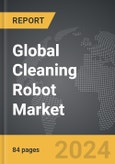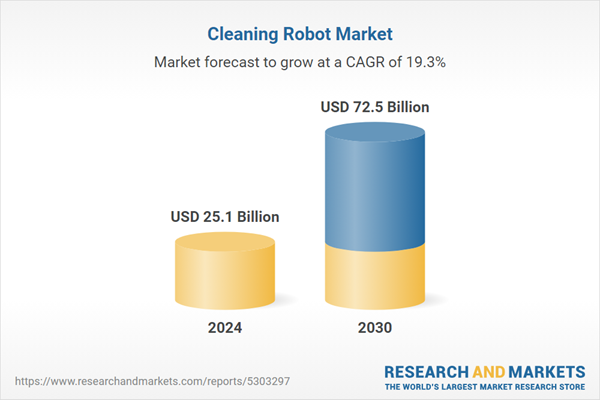Global Cleaning Robot Market - Key Trends & Drivers Summarized
Why Are Cleaning Robots Becoming Essential for Modern Households and Businesses?
Cleaning robots have rapidly transitioned from novelty items to essential tools in both residential and commercial settings, driven by their convenience, efficiency, and ability to tackle routine cleaning tasks autonomously. These devices have gained popularity due to the increasing demand for automated, labor-saving solutions that can keep homes and workplaces clean without requiring constant human oversight. For busy households, especially those with dual-income earners, cleaning robots provide a practical solution for maintaining cleanliness with minimal effort. In commercial settings, cleaning robots are increasingly used in hotels, hospitals, airports, and retail spaces where consistent hygiene is essential. The COVID-19 pandemic further underscored the importance of cleanliness, accelerating the adoption of automated cleaning solutions to minimize human intervention and reduce the risk of cross-contamination. Furthermore, as urbanization and the rise of smart homes continue to shape consumer expectations, cleaning robots have found a foothold in homes and businesses alike, with growing acceptance as efficient, time-saving appliances that adapt to modern lifestyles.How Are Technological Advancements Enhancing the Capabilities of Cleaning Robots?
The cleaning robot market is witnessing rapid advancements in technology, which have enhanced both the efficiency and functionality of these devices. Innovations in artificial intelligence (AI) and machine learning (ML) are central to this evolution, enabling robots to map their surroundings, recognize obstacles, and learn optimal cleaning paths with precision. These technologies allow for real-time adaptive navigation, ensuring cleaning robots can maneuver around furniture, walls, and other obstacles seamlessly. Furthermore, integration with smart home systems, such as voice-activated assistants like Alexa or Google Home, has made it possible for users to control cleaning robots through simple voice commands, enhancing user convenience. Sensor technology has also advanced significantly; modern cleaning robots are equipped with sensors for dust, humidity, and surface detection, allowing them to adjust suction power and cleaning modes based on floor type and dirt levels. The development of wet-and-dry functionality, self-emptying dustbins, and automatic recharging and resumption features has further enhanced their convenience. These technological strides have not only increased the effectiveness of cleaning robots but have also expanded their versatility, making them suitable for a wider range of environments and more demanding cleaning tasks.Which Non-Residential Sectors Are Driving the Growing Demand for Cleaning Robots?
While cleaning robots initially gained popularity in the residential sector, they are increasingly being adopted across various non-residential sectors due to their efficiency and ability to ensure consistent cleaning standards. In healthcare, for example, hospitals and clinics are using UV-equipped cleaning robots to disinfect surfaces and reduce infection risks, particularly in high-touch areas. The hospitality industry, including hotels and restaurants, has also embraced cleaning robots to streamline maintenance tasks, ensuring high standards of cleanliness for guests while reducing labor costs. Retail and shopping malls, where cleanliness and aesthetics are integral to customer experience, are deploying floor-cleaning robots to ensure uninterrupted hygiene and enhance operational efficiency. Airports, warehouses, and manufacturing facilities are further examples where cleaning robots are in high demand, as they help maintain clean and safe environments, especially in areas with large floor spaces that require frequent maintenance. These expanding applications in non-residential settings underscore the growing versatility and necessity of cleaning robots across industries that prioritize hygiene and efficiency, highlighting their role in supporting consistent, high-quality cleaning standards without the need for constant human involvement.What's Driving Growth in the Cleaning Robot Market?
The growth in the cleaning robot market is driven by several factors, including advancements in AI and sensor technology, the increasing emphasis on hygiene, and shifting consumer preferences toward automation. Technological advancements in AI and sensor integration have enabled cleaning robots to navigate complex spaces, identify cleaning patterns, and adjust to different floor types and cleaning requirements, greatly improving their functionality and appeal. The heightened awareness around hygiene, especially in the wake of the COVID-19 pandemic, has also spurred demand across both residential and commercial sectors, as consumers and businesses prioritize cleanliness with minimal manual intervention. Consumer preferences are increasingly shifting toward smart, automated solutions that enhance convenience, especially in urban areas where busy lifestyles make routine cleaning challenging. The rise of smart homes has also created a seamless integration for cleaning robots, allowing them to sync with other IoT-enabled devices, further enhancing their functionality. Additionally, non-residential applications, including healthcare, hospitality, and retail, are increasingly deploying cleaning robots to uphold hygiene standards and optimize labor costs. Together, these trends indicate strong growth potential for the cleaning robot market as technological improvements and expanding applications continue to drive adoption across diverse sectors.Report Scope
The report analyzes the Cleaning Robot market, presented in terms of market value (US$ Thousand). The analysis covers the key segments and geographic regions outlined below.- Segments: Type (Personal, Professional); Product (Floor Cleaning Robot, Lawn Cleaning Robot, Pool Cleaning Robot, Window Cleaning Robot, Other Products); Application (Residential, Commercial, Industrial, Other Applications).
- Geographic Regions/Countries:World; United States; Canada; Japan; China; Europe (France; Germany; Italy; United Kingdom; and Rest of Europe); Asia-Pacific; Rest of World.
Regional Analysis
Gain insights into the U.S. market, valued at $7.2 Billion in 2024, and China, forecasted to grow at an impressive 18.8% CAGR to reach $11.3 Billion by 2030. Discover growth trends in other key regions, including Japan, Canada, Germany, and the Asia-Pacific.Why You Should Buy This Report:
- Detailed Market Analysis: Access a thorough analysis of the Global Cleaning Robot Market, covering all major geographic regions and market segments.
- Competitive Insights: Get an overview of the competitive landscape, including the market presence of major players across different geographies.
- Future Trends and Drivers: Understand the key trends and drivers shaping the future of the Global Cleaning Robot Market.
- Actionable Insights: Benefit from actionable insights that can help you identify new revenue opportunities and make strategic business decisions.
Key Questions Answered:
- How is the Global Cleaning Robot Market expected to evolve by 2030?
- What are the main drivers and restraints affecting the market?
- Which market segments will grow the most over the forecast period?
- How will market shares for different regions and segments change by 2030?
- Who are the leading players in the market, and what are their prospects?
Report Features:
- Comprehensive Market Data: Independent analysis of annual sales and market forecasts in US$ Million from 2024 to 2030.
- In-Depth Regional Analysis: Detailed insights into key markets, including the U.S., China, Japan, Canada, Europe, Asia-Pacific, Latin America, Middle East, and Africa.
- Company Profiles: Coverage of players such as Alfred Kärcher, AMANO Corporation, Avidbots, Bissell Homecare, bObsweep and more.
- Complimentary Updates: Receive free report updates for one year to keep you informed of the latest market developments.
Some of the 23 companies featured in this Cleaning Robot market report include:
- Alfred Kärcher
- AMANO Corporation
- Avidbots
- Bissell Homecare
- bObsweep
- Cyberdyne
- Dyson
- Ecovacs Robotics
- Gaussian Robotics
- ILIFE
- Intellibot Robotics
- iRobot
- LG Electronics
- Makita Corporation
- Miele
- Monoprice
- Neato Robotics
- Samsung Electronics
- Tennant Company
- Vorwerk
This edition integrates the latest global trade and economic shifts into comprehensive market analysis. Key updates include:
- Tariff and Trade Impact: Insights into global tariff negotiations across 180+ countries, with analysis of supply chain turbulence, sourcing disruptions, and geographic realignment. Special focus on 2025 as a pivotal year for trade tensions, including updated perspectives on the Trump-era tariffs.
- Adjusted Forecasts and Analytics: Revised global and regional market forecasts through 2030, incorporating tariff effects, economic uncertainty, and structural changes in globalization. Includes historical analysis from 2015 to 2023.
- Strategic Market Dynamics: Evaluation of revised market prospects, regional outlooks, and key economic indicators such as population and urbanization trends.
- Innovation & Technology Trends: Latest developments in product and process innovation, emerging technologies, and key industry drivers shaping the competitive landscape.
- Competitive Intelligence: Updated global market share estimates for 2025, competitive positioning of major players (Strong/Active/Niche/Trivial), and refined focus on leading global brands and core players.
- Expert Insight & Commentary: Strategic analysis from economists, trade experts, and domain specialists to contextualize market shifts and identify emerging opportunities.
Table of Contents
Companies Mentioned (Partial List)
A selection of companies mentioned in this report includes, but is not limited to:
- Alfred Kärcher
- AMANO Corporation
- Avidbots
- Bissell Homecare
- bObsweep
- Cyberdyne
- Dyson
- Ecovacs Robotics
- Gaussian Robotics
- ILIFE
- Intellibot Robotics
- iRobot
- LG Electronics
- Makita Corporation
- Miele
- Monoprice
- Neato Robotics
- Samsung Electronics
- Tennant Company
- Vorwerk
Table Information
| Report Attribute | Details |
|---|---|
| No. of Pages | 212 |
| Published | December 2025 |
| Forecast Period | 2024 - 2030 |
| Estimated Market Value ( USD | $ 25.1 Billion |
| Forecasted Market Value ( USD | $ 72.5 Billion |
| Compound Annual Growth Rate | 19.3% |
| Regions Covered | Global |









